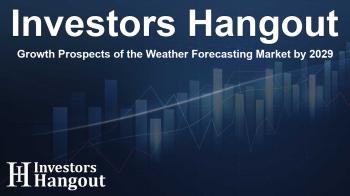Growth Prospects of the Weather Forecasting Market by 2029

Overview of the Weather Forecasting System Market
The weather forecasting system market is on an upward trajectory, with forecasts indicating a potential reach of USD 832.2 million by 2029, building from USD 620.1 million in 2024. This growth, marked by a compound annual growth rate (CAGR) of 6.1%, shows the increasing reliance on advanced weather prediction technologies.
Drivers of Market Growth
A significant factor driving this growth is the rising demand for precise weather predictions in agriculture. As agricultural sectors strive for efficiency, they heavily depend on weather forecasts to inform crucial decisions regarding planting and harvesting. The United States, boasting the highest number of airports worldwide, also influences this market substantially; the aviation industry necessitates reliable forecasting systems to ensure safe operations.
The Role of Advanced Technology
Innovative technologies such as artificial intelligence, machine learning, and big data are transforming how weather data is collected and analyzed. The integration of these technologies can help provide timely and accurate weather information, which is paramount across various sectors, including agriculture and energy.
Application in the Aviation Sector
In the aviation sector, streamlined operations hinge on accurate weather information. Upgraded weather forecasting systems help mitigate risks associated with flight delays and cancellations, enhancing passenger safety and improving operational efficiency. This acceleration in modernization within the aviation sphere is a vital contributor to the market's expansion.
Key Players in the Weather Forecasting Industry
The weather forecasting system industry comprises formidable players who are at the forefront of supplying weather data and analysis tools. Notable names include Vaisala from Finland, DTN, Accuweather, and The Weather Company from the US. These organizations leverage state-of-the-art tools to provide unique solutions catering to diverse market needs.
Market Segmentation Insights
The weather forecasting market can be segmented into hardware and software solutions. Currently, the hardware segment leads the market, incorporating instruments like barometers, anemometers, rain gauges, and satellite sensors. Each element functions in harmony to collect precise weather data.
The Meteorology Vertical
Within vertical markets, the meteorology sector absorbs a significant portion of the forecasting market's share. Solutions tailored for meteorological applications encompass innovative forecasting systems which leverage comprehensive data sources. This integration of meteorology and technology allows for improved forecasting accuracy, which is in high demand by various industries.
Emerging Trends with Satellites and Drones
Both satellites and drones are making strides in enhancing weather forecasting capabilities in the US. Employing satellites increases the granularity of data available regarding atmospheric conditions, while drones facilitate localized data collection essential for immediate accuracy, especially in hard-to-reach areas. The synergy created between these two technologies is pivotal for advancing forecasting capabilities.
Challenges in the Market
Despite the promising growth, the weather forecasting market faces challenges, primarily stemming from the complex dynamics of atmospheric variables. Continuous weather monitoring is essential, especially for disaster management, but inaccuracies can lead to false alarms negatively impacting public perception and trust in weather forecasting systems.
Future Outlook
As climate variability and extreme weather events become more prevalent, the demand for accurate data will only continue to rise. Future projections indicate considerable market growth fueled by innovations aimed at minimizing the impact of severe weather conditions, enhancing disaster preparedness and overall public safety.
Frequently Asked Questions
1. What is the projected growth of the weather forecasting system market?
The weather forecasting system market is expected to reach USD 832.2 million by 2029, indicating a steady growth trajectory.
2. How does technology play a role in weather forecasting?
Technology, including AI and big data, enhances data accuracy and timeliness, crucial for various sectors like agriculture and aviation.
3. Who are the key players in the weather forecasting market?
Major players include Vaisala, DTN, Accuweather, and The Weather Company, all contributing innovative solutions to the market.
4. What challenges does the weather forecasting market face?
The market faces challenges related to atmospheric variability, which can lead to inaccuracies and subsequently false alarms.
5. What role do satellites and drones have in modern forecasting?
Satellites and drones significantly enhance local and regional data collection, improving forecast accuracy and responsiveness to weather phenomena.
About The Author
Contact Dominic Sanders privately here. Or send an email with ATTN: Dominic Sanders as the subject to contact@investorshangout.com.
About Investors Hangout
Investors Hangout is a leading online stock forum for financial discussion and learning, offering a wide range of free tools and resources. It draws in traders of all levels, who exchange market knowledge, investigate trading tactics, and keep an eye on industry developments in real time. Featuring financial articles, stock message boards, quotes, charts, company profiles, and live news updates. Through cooperative learning and a wealth of informational resources, it helps users from novices creating their first portfolios to experts honing their techniques. Join Investors Hangout today: https://investorshangout.com/
The content of this article is based on factual, publicly available information and does not represent legal, financial, or investment advice. Investors Hangout does not offer financial advice, and the author is not a licensed financial advisor. Consult a qualified advisor before making any financial or investment decisions based on this article. This article should not be considered advice to purchase, sell, or hold any securities or other investments. If any of the material provided here is inaccurate, please contact us for corrections.

